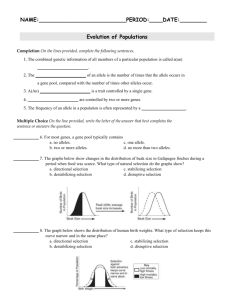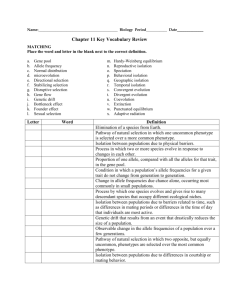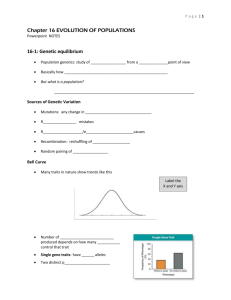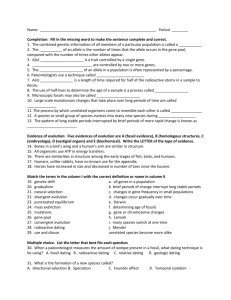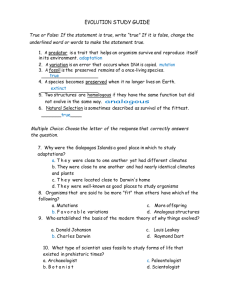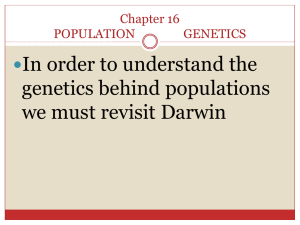Chs 15-17 Evolution Test Review
advertisement
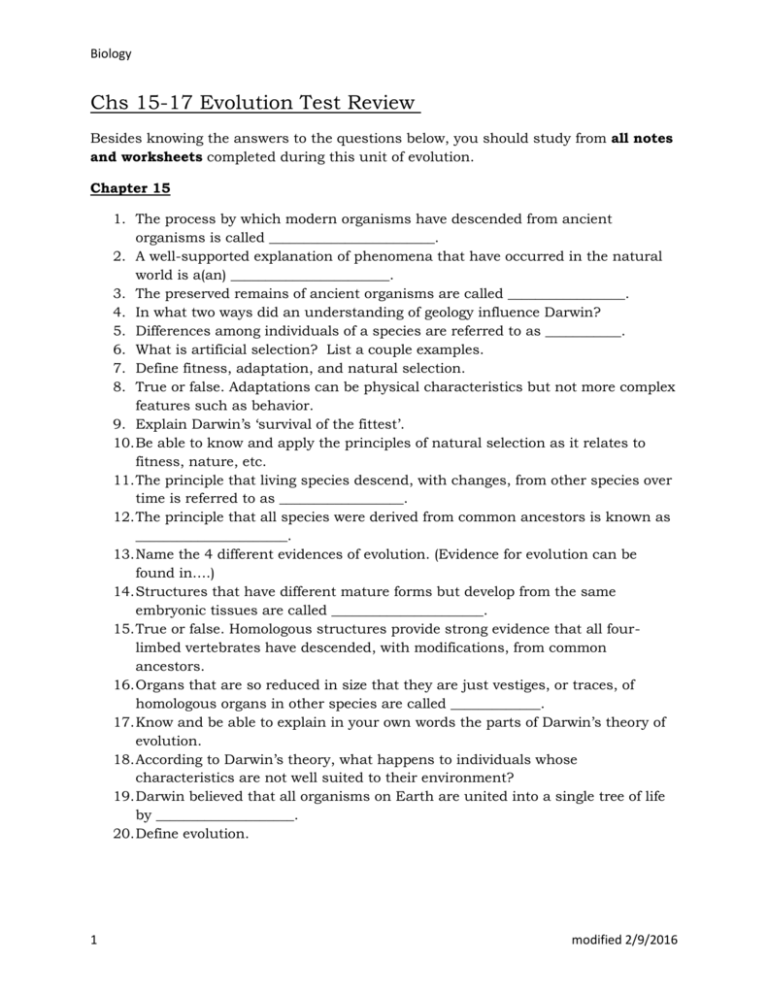
Biology Chs 15-17 Evolution Test Review Besides knowing the answers to the questions below, you should study from all notes and worksheets completed during this unit of evolution. Chapter 15 1. The process by which modern organisms have descended from ancient organisms is called ________________________. 2. A well-supported explanation of phenomena that have occurred in the natural world is a(an) _______________________. 3. The preserved remains of ancient organisms are called _________________. 4. In what two ways did an understanding of geology influence Darwin? 5. Differences among individuals of a species are referred to as ___________. 6. What is artificial selection? List a couple examples. 7. Define fitness, adaptation, and natural selection. 8. True or false. Adaptations can be physical characteristics but not more complex features such as behavior. 9. Explain Darwin’s ‘survival of the fittest’. 10. Be able to know and apply the principles of natural selection as it relates to fitness, nature, etc. 11. The principle that living species descend, with changes, from other species over time is referred to as __________________. 12. The principle that all species were derived from common ancestors is known as ______________________. 13. Name the 4 different evidences of evolution. (Evidence for evolution can be found in….) 14. Structures that have different mature forms but develop from the same embryonic tissues are called ______________________. 15. True or false. Homologous structures provide strong evidence that all fourlimbed vertebrates have descended, with modifications, from common ancestors. 16. Organs that are so reduced in size that they are just vestiges, or traces, of homologous organs in other species are called _____________. 17. Know and be able to explain in your own words the parts of Darwin’s theory of evolution. 18. According to Darwin’s theory, what happens to individuals whose characteristics are not well suited to their environment? 19. Darwin believed that all organisms on Earth are united into a single tree of life by ____________________. 20. Define evolution. 1 modified 2/9/2016 Biology 1. The combined genetic information of all members of a particular population is called a(an) ________________________ . 2. The _______________________ of an allele is the number of times that the allele occurs in a gene pool, compared with the number of times other alleles occur. 3. A(An) _________________________ is a trait controlled by a single gene. 4. _______________________are controlled by two or more genes. 5. The _______________________ of an allele in a population is often represented by a percentage. Multiple Choice On the line provided, write the letter of the answer that best completes the sentence or answers the question. ___________ 6. For most genes, a gene pool typically contains a. no alleles. c. one allele. b. two or more alleles. d. no more than two alleles. ___________ 7. The graphs below show changes in the distribution of beak size in Galápagos finches during a period when food was scarce. What type of natural selection do the graphs show? ___________ 8. a. directional selection c. stabilizing selection b. destabilizing selection d. disruptive selection The graph below shows the distribution of human birth weights. What type of selection keeps this curve narrow and in the same place? a. directional selection 2 c. stabilizing selection modified 2/9/2016 Biology ___________ 9. What type of natural selection takes place when individuals at the upper and lower ends of the curve have higher fitness than individuals near the middle? a. directional selection c. stabilizing selection b. destabilizing selection d. disruptive selection ___________ 10. A random change in allele frequency is called a. fitness. b. genetic drift. ___________ 11. Genetic drift is more likely to occur in a. large populations. c. speciation. d. the founder effect. c. small populations. b. medium-sized populations. d. a single individual. ___________ 12. What occurs when allele frequencies change as a result of the migration of a small subgroup of a population? a. directional selection c. speciation b. the founder effect d. genetic equilibrium ___________ 13. What principle states that the frequency of an allele in a population will remain constant unless one or more factors cause that frequency to change? a. the speciation principle c. the Hardy-Weinberg principle b. the genetic equilibrium principle d. the genetic-drift principle ___________ 14. The situation in which allele frequencies do not change is called a. genetic equilibrium. c. behavioral equilibrium. b. stabilizing equilibrium. d. directional selection. ___________ 15. Which of the following is required to maintain genetic equilibrium? a. The population must be small. b. No mutations occur. c. Individuals move between populations. d. Natural selection occurs. ___________ 16. What is the formation of a new species called? a. directional selection b. speciation 3 c. founder effect d. temporal isolation modified 2/9/2016 Biology ___________ 17. What situation occurs when members of two different species cannot interbreed and produce fertile offspring? a. reproductive isolation c. genetic drift b. genetic equilibrium d. natural selection ___________ 18. What kind of isolation occurs when two populations are capable of interbreeding but have differences in courtship rituals or other types of behavior? a. courtship isolation c. geographic isolation b. behavioral isolation d. temporal isolation ___________ 19. Two populations kept separate by a river are characterized by a. genetic drift. c. geographic isolation. b. disruptive selection. d. temporal isolation. ___________ 20. What situation occurs when two or more species reproduce at different times? a. stabilizing selection c. geographic isolation b. behavioral isolation d. temporal isolation Chapter 17 1. Know the definition and examples of convergent evolution. 2. Know the definition and examples of divergent evolution. 3. Be able to number sedimentary layers and determine which layer would have more complex creatures. 4. What was Pangaea? What evidences for Pangaea are there? 5. Scientists who study fossils are called __________________________. 6. Explain/give examples for microbiologic similarities that give evidence for the theory of evolution. 4 modified 2/9/2016

